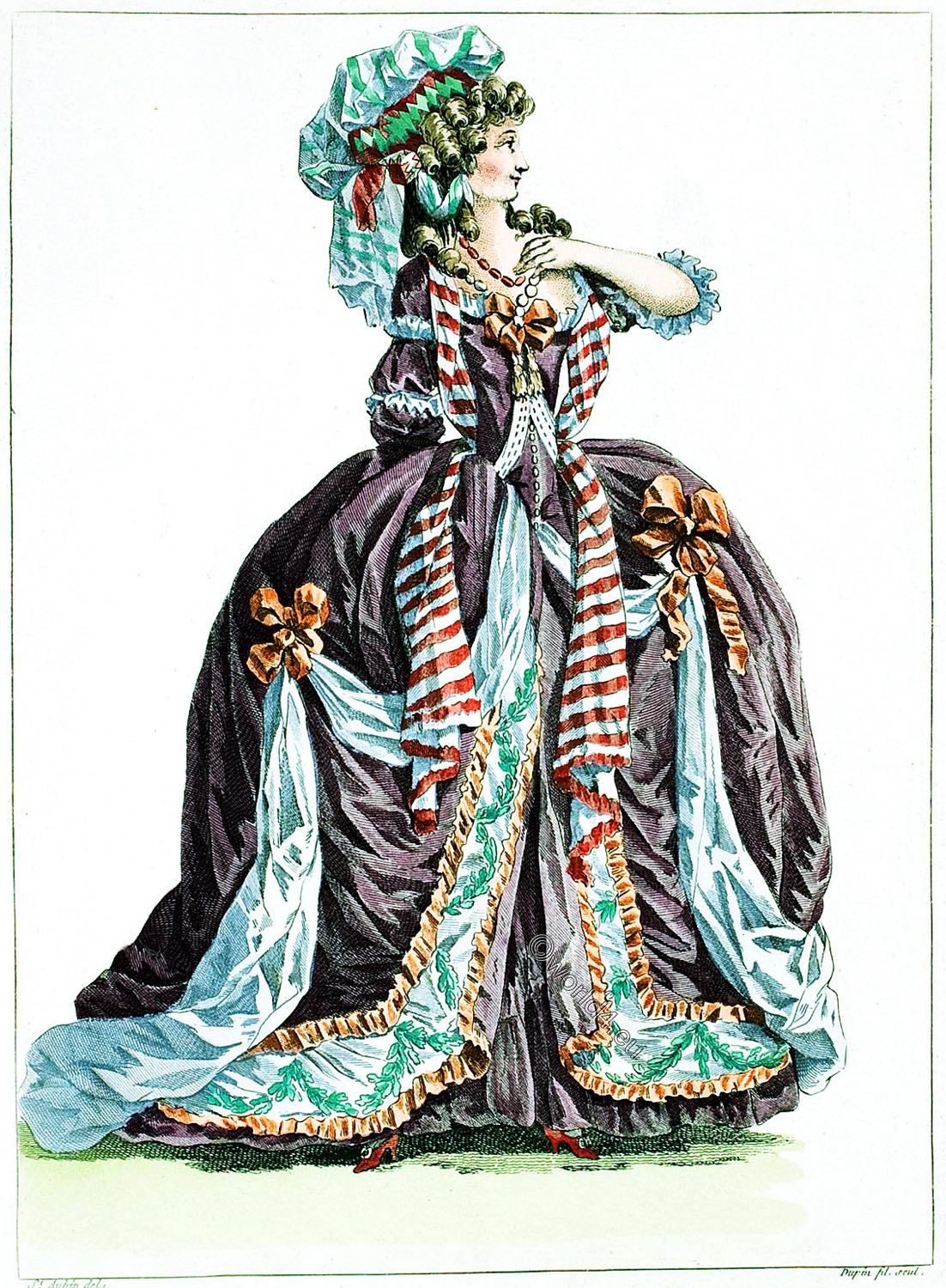Young Lady in a taffeta dress, 1775.
Jeune Dame, vetu d’une Robe à la Polonaise de Taffetas uni, garni en Linon, Bonet à la Glaneuse.
Young Lady in a taffeta dress in the Polish style. Decorated with fine linen lace. Hairstyle by type of farming Gleaners.
The oldest Polish style (about 1772-1780) is a modification of the robe à l’Anglaise, which differs from that, is that the dress skirt is gathered up at the back with the help of two cords or ribbons. In most cases the tapes were attached to the inside of the waist line and pulled through the inside of the skirt installed loops, so that the gathering could be strengthened or weakened by shorten or lengthen the straps. There are next copies, in which the cords of the one end of the outside, are attached to the other inside of the waist line. In this case, no height adjustment is possible. The gathers at two sites results in a visual tripartite division of the skirt, which will be responsible for the naming, since 1772, when the polonaise became fashionable, the partitions of Poland began. The rear bagging skirt accented by a cul de Paris called padding part.
The Glaneuse (Bonet à la Glaneuse, Les Glaneuses) referenced, to the gleaning (Pickings). It was a common method of harvesting the lower social strata of a village. Which occur after the section and removal of the grain on the field remaining ears of corn were searched and collected at harvest time.
Source: 1er Cahier de la Collection d’habillements modernes et galants avec les habillements des princes et seigneurs. Paris 1780. Dessiné par Claude-Louis Desrais; Gravé par Martial Deny; Carl de Vinck. Éditeur et marchand, André Basset. Published in the Galerie des modes et costumes français, by Jacques Esnault and Michel Rapilly.
Related:
Louis XIV. , Louis XV. , Louis XVI., Baroque, Rococo, Directoire, French Revolution, Regency, Empire, Restoration or Romanticism fashion era. German Biedermeier.
- The French Fashion History.
- Reign of Charles IX. 1560 to 1574. (Tudor, Renaissance, Spanish court dress)
- Reign of Henri III. 1574 to 1589. (Renaissance, early Baroque, Spanish court dress, Tudor)
- Reigns of Henri IV. and Louis XIII. 1589 to 1643. (Baroque)
- Reign of Louis XIV. 1643 to 1715. (Baroque)
- The Reign of Louis XV. 1715 to 1774.
- Reign of Louis XVI. 1780 to 1789.
- The French Republic 1789 to 1802.
- Timeline of the French Revolution 1789 – 1799.
- Les Modes sous la revolution 1792-1799 by Paul Louis Victor de Giafferri.
- Reign of Napoleon I. 1804 to 1814. France empire.
- Reigns of Louis XVIII. and Charles X. 1815 to 1830. Restoration, Romanticism
- Fashion in the Reign of Philippe. 1830 to 1848. Victorian era. Romanticism fashion.
- The Second Republic. 1848 -1851. Victorian era. “Second Rococo”.
- The use of the Corset in the reign of Louis XVI.
- Ladies hat styles from 1776-1790 by Rose Bertin.
- Fashion under the French revolution 1789 to 1802.
- Paris fashion 1793 to 1795. French revolution.
- The Execution of the King Louis XVI.
- The Execution of Marie-Antoinette.
- The Incroyables and Muscadins. The French directory dandies.
- Les Incroyables et Merveilleuses. Directoire fashion by Horace Vernet.
- Nymphs and Merveilleuses. By Octave Uzanne.
- Fashion in Paris after the Revolution. By Octave Uzanne. 1796-1800.
- Portraits by people during the French Revolution
- The Gallery of Fashion. by Nikolaus von Heideloff, London.
- Comparison of the French and English modes. 1808 to 1815
- The Salon of Madame Récamier during the French Revolution.
- The Salons of Paris before the French Revolution.
- Caraco à la francaise in 1786.
- The Evolution of Modern Feminine Fashion 1786.
- Fashion in Paris and London, 1780 to 1788.
- Historic hairstyles from Ancient times to the Empire.
- The Corset and the Crinolin from Remote Periods to the Present Time.
- Lace History. Reference List of Italian Laces.
- Collection of antique fabric design.
[sitecreator show=”19″]







